
Next year, there will be 18 MotoE Ducati bikes on track competing in the FIM MotoE World Cup. Today, Ducati released a trove of information regarding the technological aspects of its MotoE prototype, which is already in an “advanced stage” of development.
In the press release that follows, among many other things, Ducati reminds us that it is part of the massive Volkswagen Group that includes numerous automobile brands, including, for example, Porsche and Lamborghini. VW, of course, has spent huge amounts on R&D for electric vehicles. Ducati says its MotoE racer will incorporate “technical solutions never adopted before for battery, motor and inverter.”
Here is the press release, followed by a video from Ducati:
–Ducati presents the technical details of the “V21L” prototype, the first electric motorcycle from the Bologna-based manufacturer
–Ducati MotoE comes from the close collaboration between the R&D department of Ducati and Ducati Corse: it integrates technical solutions never adopted before for battery pack, motor and inverter
–The development of the project is already in an advanced stage and is proceeding at a rapid pace towards 2023, the year in which Ducati will take on the role of sole supplier of the FIM MotoE™ World Cup with 18 electric bikes on the track every race weekend
Borgo Panigale (Bologna, Italy), 30 June 2022 – Ducati unveils the technical details of the MotoE project.
“V21L” in Borgo Panigale identifies Ducati’s first electric motorcycle, a prototype that starting from 2023 will compete in the FIM MotoE™ World Cup, of which the Bologna-based motorcycle manufacturer will be a partner as sole supplier with 18 bikes on the track during each race weekend.
The MotoE project has strategic relevance for Ducati since it makes it possible to develop expertise for the future while maintaining the approach that has always fuelled the DNA of the Bologna-based manufacturer: experimenting with technological solutions in the world of racing and working to ensure that everything that is developed in this area can then transfer to motorcycles destined for enthusiastic Ducatisti from all over the world.
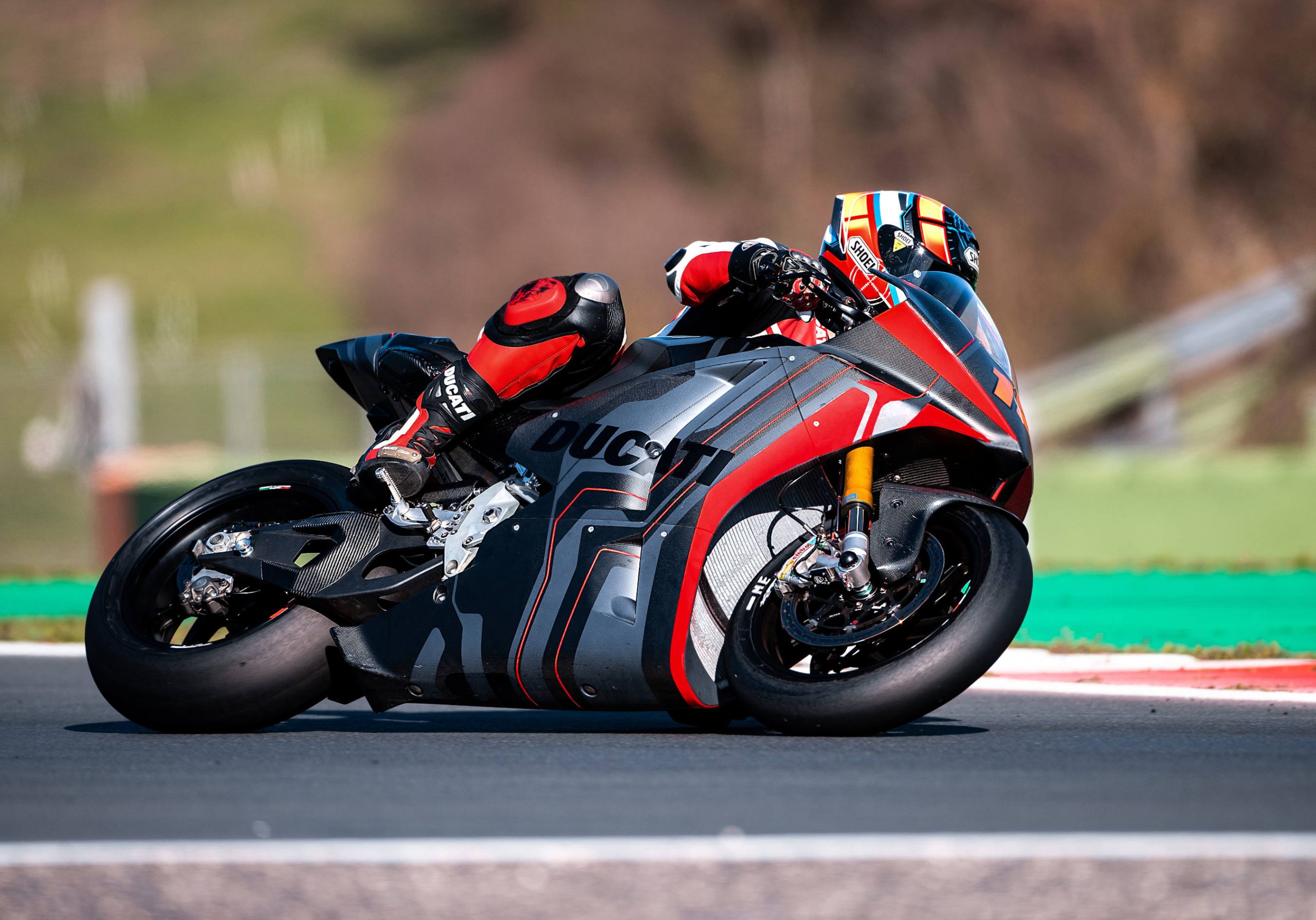
Claudio Domenicali, Ducati CEO: “A few weeks ago I had the extraordinary opportunity to ride the Ducati MotoE on the track and I immediately realized that I was living in a historic moment. The world is going through a complex period and environmental sustainability is an element that all individuals and all companies must consider a priority if we want to preserve the delicate balance of the planet. As Ducati, we have grasped this need and we went in search of a challenge that would allow us to contribute to the common goal of reducing CO₂ emissions and at the same time to keep faith with our DNA linked to racing. We agreed with determination to develop the most performing electric racing bike that current technology makes possible and to use this project as a laboratory in which to build our future. The result we have achieved is surprising. As soon as I sat on the bike I realized the quality of the work done by the team and when I returned to the garage I felt a deep sense of pride for what we were once again able to achieve.”
To produce the MotoE prototype, the Bologna-based motorcycle manufacturer put together a team that unites Ducati and Ducati Corse designers, creating a truly extraordinary mix of skills. The creation of the bike followed the procedure that is usually adopted for production bikes, triggering a close collaboration between the members of the team that led to new ways of thinking and designing, encouraged by such a technologically challenging project.
The division of tasks and the continuous dialogue between the people who make up the team were fundamental throughout the process. Ducati R&D took care of all the Project Management activities, together with the design and simulations on the electric powertrain, while the design of the MotoE was taken care by the Centro Stile Ducati which also created the livery of the bike.
Ducati Corse, on the other hand, worked on the electronic parts design, on the software controls and strategies, on the simulations of the dynamics and aerodynamics of the motorcycle and finally on the bike assembly, testing and data acquisition processes.
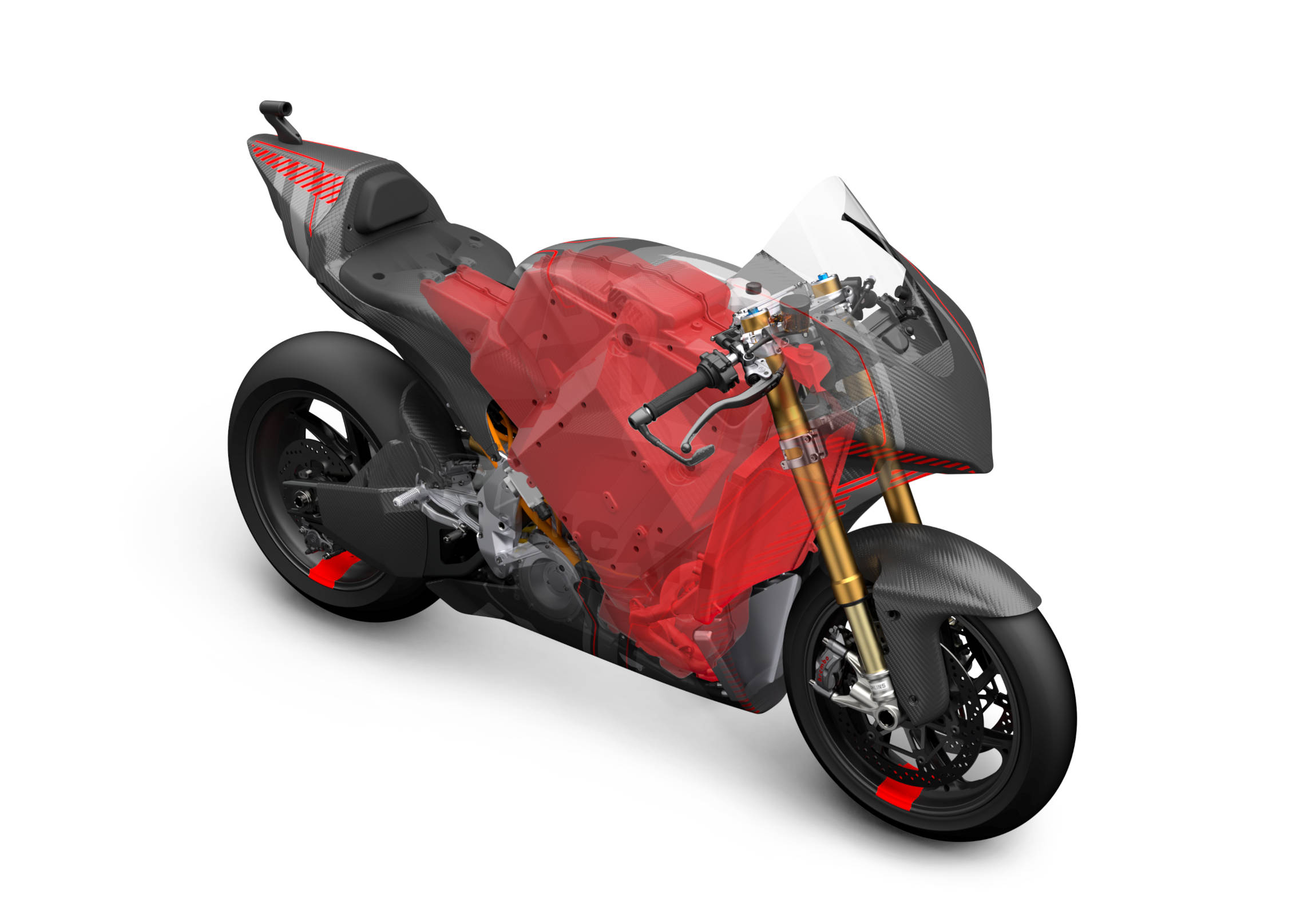
The result to date is already satisfactory: the Ducati MotoE has a total weight of 225 kg (12 kg less than the minimum requirements imposed by Dorna and FIM for a bike capable of completing the race distance) and can count on maximum power and torque figures of 110 kW (150 hp) and 140 Nm respectively, which allowed it to reach a speed of 275 km/h on a circuit like Mugello (Italy).
Vincenzo De Silvio, Ducati R&D Director: “For Ducati, having the opportunity to become suppliers of the FIM MotoE™ World Cup is not only a technologically exciting venture, but also the best way to interpret the challenges of the new millennium. Racing competition represents the ideal terrain on which to develop innovative technologies that will then transfer to production motorcycles. At this moment, the most important challenges in this field remain those related to the size, weight, autonomy of the batteries and the availability of the charging networks. Ducati’s experience in the FIM MotoE™ World Cup will be a fundamental support for product R&D, together with the physiological evolution of technology and chemistry. Helping the company’s internal expertise to grow is already essential today to be ready when the time comes to put the first street electric Ducati into production.”
The mix of expertise, passion and work of the Ducati MotoE team has led to the birth of an electric motorcycle with unique technical solutions. Starting with the battery pack, the most binding and characterizing element in terms of masses and dimensions, which on the Ducati MotoE is characterized by a shape specifically designed to follow the natural course of the middle area of the bike. The battery pack weighs 110 kg and offers a capacity of 18 kWh with a 20-kW charging socket integrated into the tail. Inside there are 1,152 cylindrical cells of the “21700” type.
The inverter, with a low weight of 5 kg, is a unit derived from a high-performance model used in motor racing for electric vehicles, while the motor (21 kg weight and a maximum rotation speed of 18,000 rpm) was developed by a partner following the technical specifications provided by Ducati. The entire system is based on a voltage of 800V (with a fully charged battery pack) to maximize the output of the electric powertrain and, as a consequence, performance and range.
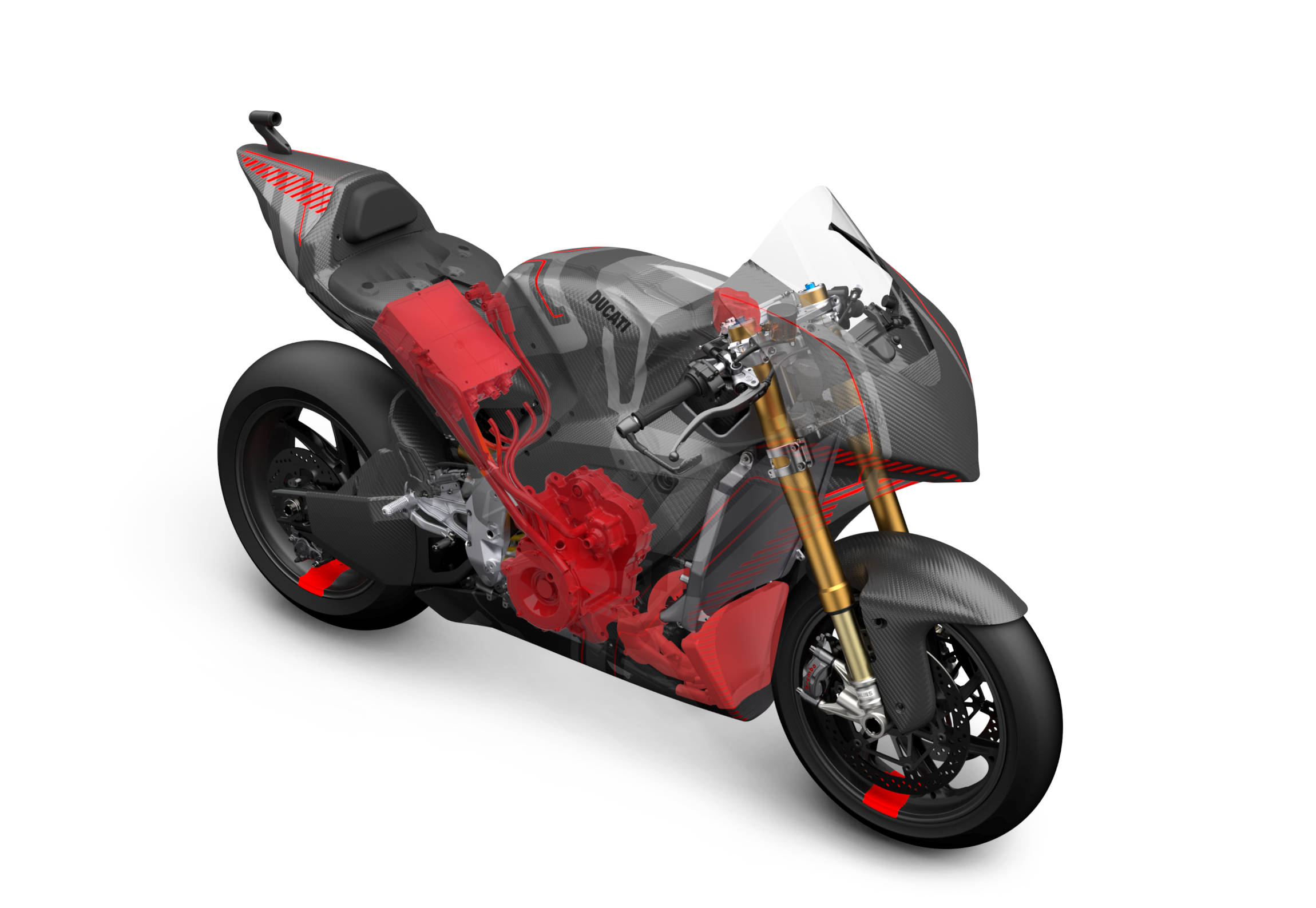
One of the most advanced technical solutions tested on the Ducati MotoE concerns the cooling system. The prototype components are in fact cooled by a particularly sophisticated and efficient liquid system with a double circuit designed to meet the different thermal needs of the battery pack and the motor/inverter unit. This guarantees extreme regularity of temperatures with important benefits in terms of consistency of performance but also in charging times. In fact, it is not necessary to wait for the battery pack to cool to start the process: the Ducati MotoE can be charged as soon as it enters the garage, and it takes about 45 minutes to recharge it up to 80% of its range.
The carbon fibre case of the battery pack also acts as a stressed part of the chassis, like what happens for the Ducati Panigale V4 engine, with an aluminium monocoque Front Frame for the front area weighing 3.7 kg. The rear is composed of an aluminium swingarm weighing 4.8 kg with a geometry like that of the Ducati Desmosedici racing in MotoGP. The rear subframe, which integrates the tail and the rider seat, is made of carbon fibre.
The suspension area features an Öhlins NPX 25/30 pressurized fork with 43 mm diameter upside-down tubes at the front, derived from the Superleggera V4, while an Öhlins TTX36 shock absorber is present at the rear and is fully adjustable. The steering damper is an adjustable Öhlins unit.
The braking system is supplied by Brembo and is sized for the specific requirements of the Ducati MotoE. At the front it is composed of a double steel disc with a diameter of 338.5 mm of increased thickness, which has fins on the internal diameter with the aim of increasing the thermal exchange surface area and improve disc cooling in conditions of extreme use on the track. Two GP4RR M4 32/36 calipers with a PR19/18 radial master cylinder operate on this double disc. At the rear, the P34 caliper acts on a single disc unit 220 mm in diameter and 5 mm thick with a PS13 master cylinder. Teams can also choose to equip their bikes with an optional rear brake control positioned on the left handlebar, which the rider can use as an alternative to the pedal one.
Roberto Canè, Ducati eMobility Director: “I remember the birth of the MotoE project and every phase of the composition of the work team well, with the involvement of Ducati Corse colleagues and the search for contacts within the Volkswagen Group who could give us suggestions on how to develop this project. To make this bike we followed the same procedure that we usually follow on a production bike. We started by defining the design of the bike and in parallel the technical office began to design the various vehicle components. The initial brief was to create a racing bike that respected the minimum performance characteristics required by Dorna. As a matter of fact, this project has made and is making the whole team involved fall in love and is pushing us to create a bike with better characteristics than initially requested by the organizer.”

The development process of the Ducati MotoE also involved the Ducati Corse test team led by Marco Palmerini, who worked on the track applying the same methodologies used in MotoGP, thanks also to the support of the riders Michele Pirro, Alex De Angelis and Chaz Davies. Through the work on the electronics, the aim was to obtain a throttle response like that of an endothermic unit and a response from the electronic controls (such as Ducati Traction Control, Ducati Slide Control, Ducati Wheelie Control and throttle/engine brake maps) indistinguishable from that of the racing bikes that Ducati riders are used to.
The possibility of applying the development and test method already used in MotoGP, with a precise sequence of tests to be carried out on the various components to maximize the performance of each day on the track, was achieved also thanks to the efficiency of the cooling system, which has reduced charging times to a minimum, thus allowing for a truly significant continuity of use for an electric motorcycle. The development work involved a specific learning and training course for all the personnel involved, exploiting the knowledge shared within the Volkswagen Group, to ensure the total safety of the rider and technicians.
The fact that Ducati belongs to the Volkswagen Group, which has made electric mobility an essential element of its “New Auto” 2030 strategy, represents the best prerequisite for an extraordinary exchange of expertise in the field of electric powertrains. Ducati is in close contact with the Group’s centres of expertise and with the Centre of Excellence (CoE) at Salzgitter in Germany, but also with other brands of the Group such as Porsche and Lamborghini.
The work plan of the Ducati MotoE project has already reached an advanced stage of development and is proceeding at a rapid pace towards 2023, the year in which Ducati will take on the role of sole supplier of the FIM MotoE™ World Cup with 18 electric motorcycles on the track every weekend. The next objective for the Bologna-based manufacturer is to take advantage of participation in the most important racing competition in the world for electric motorcycles to experiment with innovative technologies, train new skills and study how to create, as soon as the technology will allow, a Ducati electric vehicle that is sporty, light, exciting and able to satisfy all enthusiasts.
The Ducati website has now a section dedicated to the Ducati MotoE project at this link.


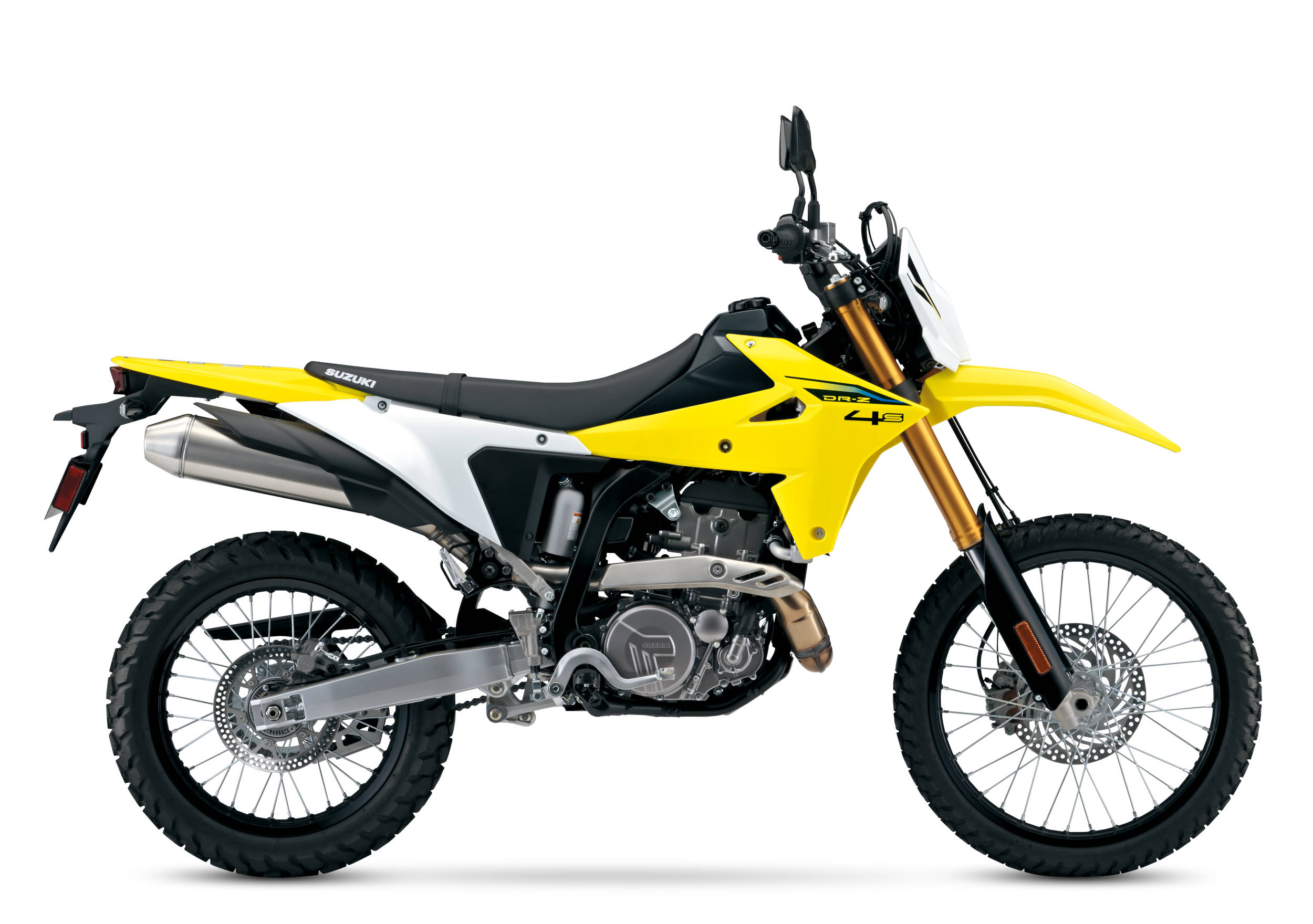
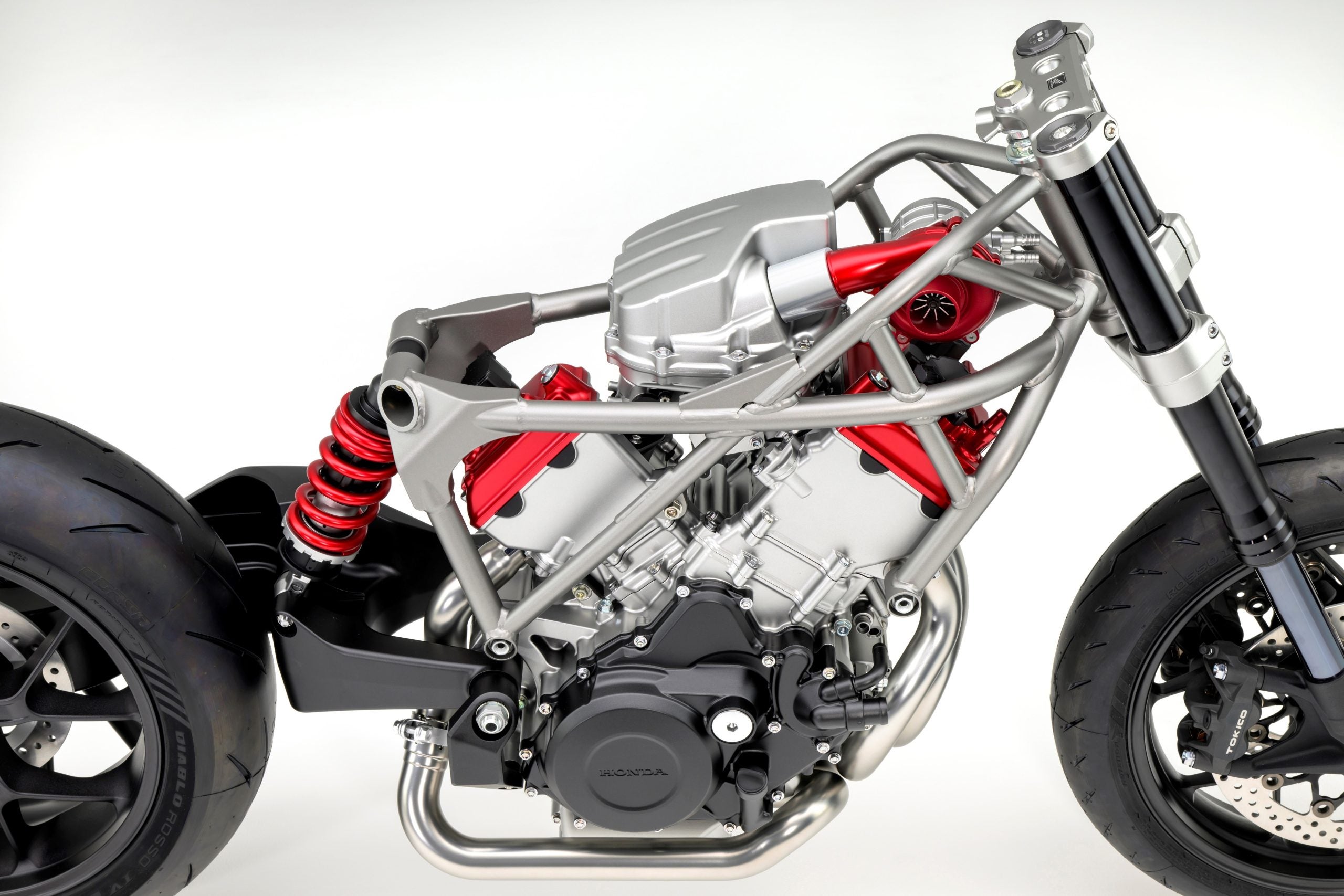
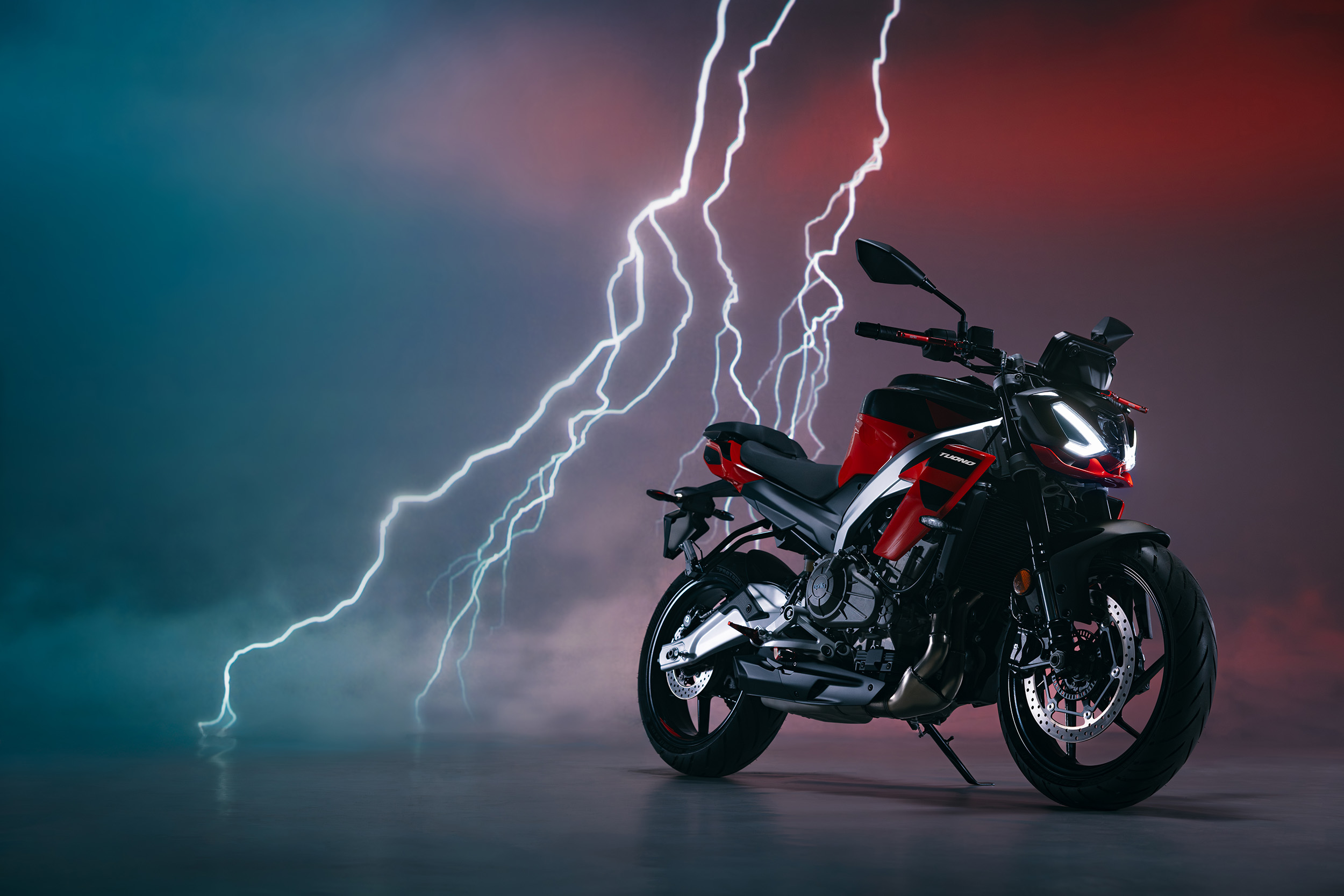
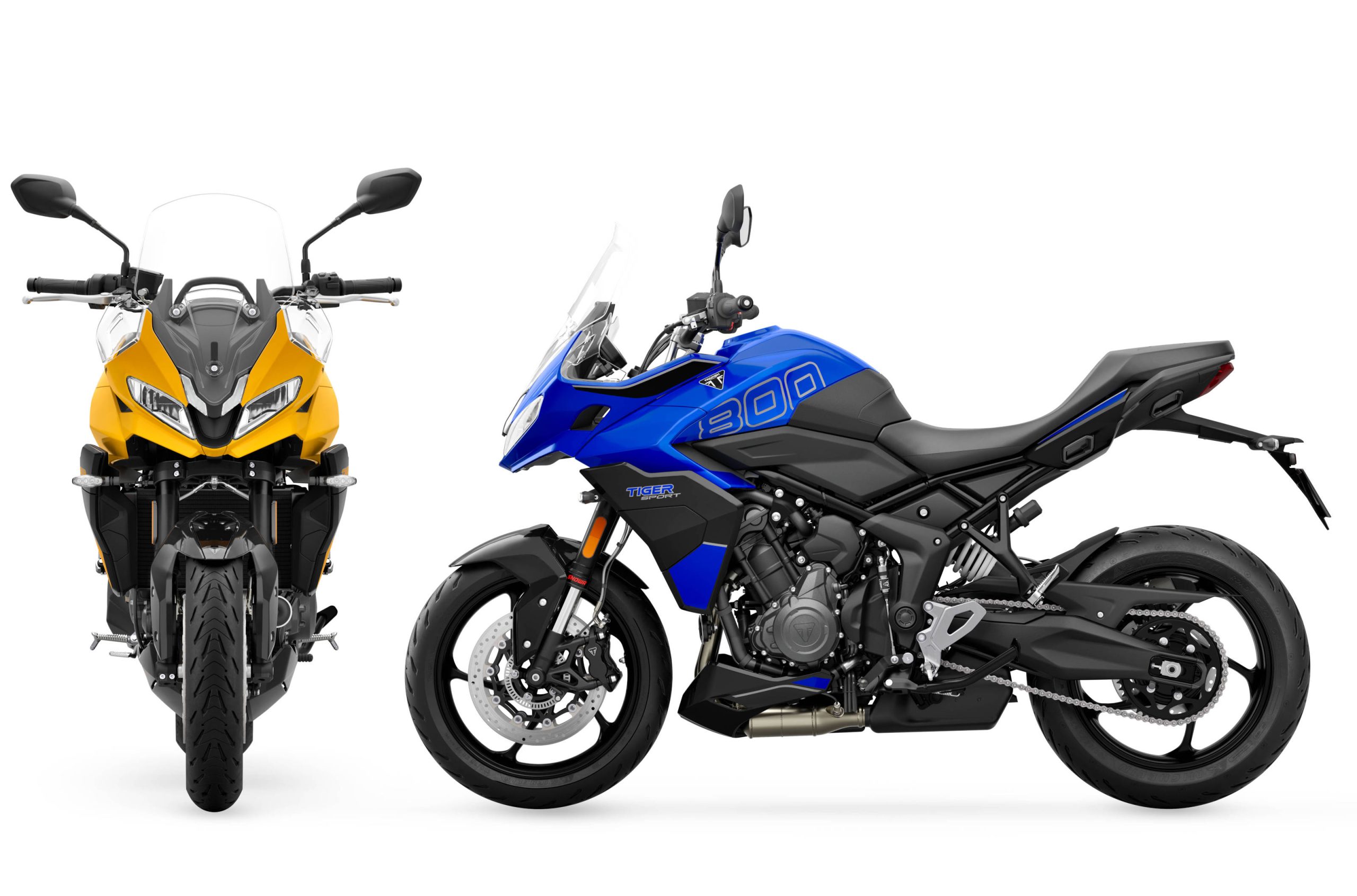
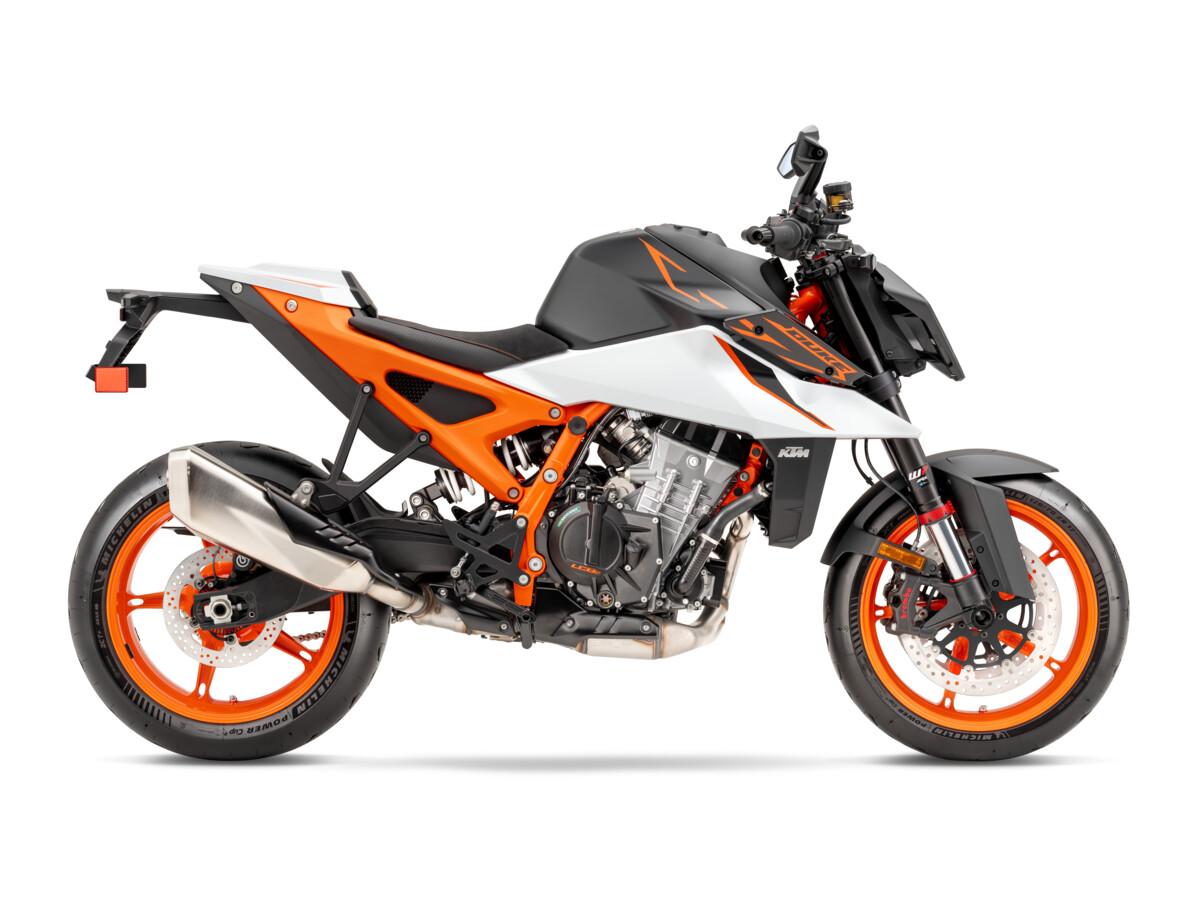
Something is not right. The web site has not been updated since June.
My guess is… Vacation.
Hey Dirck, you OK?
Petrol racing machines have long ago reached their developmental limit. The changes now are mostly incremental or rule initiated in an effort to detune or make racing “fairer.”
I will miss the sound mightily, but I’m very much looking forward to the great leaps in innovation that only a seachange can bring, and going electric is a seachange.
The above comments are either meant to be insulting and argumentative, or the poster is just plainly out of touch with reality.
Neither, I just spoke the truth. You don’t have to agree, but the changes in ICE are largely very incremental at this point. Often, to detune them.
Electric motors are where the innovation is going. Anyone can plainly see that.
Mostly yup, however IMO Everything will end up Hybrid eventually, except fighter aircraft.
That’s a darned good point, hybrids make WAY more sense for most personal transportation than pure EV’s do, if your goal is to reduce hydrocarbon use as quickly and efficiently as possible. You can make multiple hybrid vehicles with the same amount of battery capacity as is present in one EV, and have the advantage of not having to deal with range anxiety. And those multiple hybrids will save much more gas over their lifetimes than the single EV ever would, and even more if they are PHEV’s.
So yeah, good point. The jump from pure ICE to pure EV’s is simply too large to make in a single leap, and the best, first step is hybrids. Toyota has proved they can be made with excellent reliability and price points.
Teslas are a great niche for the wealthy, but they are a niche nonetheless. And I haven’t seen an EV motorcycle produced yet that is attractive to anyone beside those who value virtue signaling over utility.
Amazing to see the commenting dinosaurs wallow around in the tar, taking their last breaths on why the future doesn’t work for them right now.
I love “motor”bikes as much as the next guy, but I can’t kick the feeling that I’ve just purchased my last gasoline-burning truck and bikes. I can’t wait to ride one of these things, or something like it.
Until the brainiacs figure out how to increase battery energy density the two or three times it’s going to take to make EV street motorcycles practical, I’ll stick to wallowing in the tar. At least tar can be refined as a fuel to provide a reasonable range for a day in the saddle. Batteries are a good idea for automobiles in urban areas. For motorcycles? Not so much, at least at their current point of development.
OK fine Doc. Six guys with electric bikes are showing up at your place tomorrow. They want to ride about three hundred miles a day on back roads. It’s your job to host them and keep their bikes charged up. You best go fetch yourself up a truck and a sizable generator and follow them around.
Um… Wouldn’t charging a bunch or e-bikes with a gas or diesel generator be a little on the pointless side?
Whatever, I’ll go back to my tar pit now, take a bunch of hot laps, gas up in a jiffy, and roost some more. Have fun brainstorming the castle!
Always like when people throw out the charging the electric vehicle with a gas generator argument. Sounds kinda silly to do on the face of it but people leave out the gas mileage issue. So in a pinch let’s say I have to charge my electric vehicle with my generator. How much gas will I use? Depends on the generator but I think you could charge your Telsa if you run 2 0r 3 gallons through a generator and go 300 miles. Less if your patient and have a smaller generator. It takes something under 100 gals for my truck to do the same mileage.
You do the math.
Make that 20 gals for the truck. It’s a Toyota not a Semi. Sheesh, what’s dummy.
Okay, six guys show up at my place and want to take a 300 mile ride and the range available on each bike is 400 miles. Nobody has to wear earplugs, the bike don’t vibrate, nobody has to take half their luggage off to fuel the bike.
Two can play this pointless game. Keep staring at the single tree right in front of you.
400 miles range ebikes… Probably shouldn’t hold that last breath in the tar pit. 😀
It will be a while before electric bikes have a 400 mile range and the first of those will be terribly heavy things that nobody will want to ride. And so far all the range listed for the electric bikes is uban range. Those 400 mile range bikes will probably go flat in 250 miles of dancing down rural twisties. Now you’re in the middle of nowhere and need a 100kw generator to charge you all up to get home.
Then you still have to charge them all at home for the next days ride. Level 2 chargers are 48 amp. Six of your buds and you will require seven 50 amp outlets and 350 amps coming onto your property and actually being used.
Ten years from now this will still be a problem. I have been waiting for decades to benefit from advances in ICE technology. Can you buy a bike that’s between 80 and 90 horsepower that weighs less than 350 pounds? Nope! What makes you think that the street bike industry will deliver a real 400 mile range in a package that anyone would want to buy any time soon? This is an industry that sells images. They only sell excellent equipment to dirt bikers. Dirt bikers are the only people who demand it. That’s not going to change.
Here’s the “right now” and “foreseeable future”: you schedule a group ride with some friends. Nothing big, just a 70 mile ride along the scenic back roads to lunch at The Junction and then ride back. Everyone shows up, ready to go, taking the one minute required to gas up at the corner station. Doc left his home, where he had the bike on the charger overnight, and rode the 15 miles to the meetup point on the highway. His bike shows it has 70 miles remaining if he keeps it under 35 mph so he asks if he I can grab an extension cord and “top up”. This gives us some time to talk about restoring the old Norton check out the mods Mick did to his XR. After about an hour Doc checks his bike and it now shows 80 miles remaining so we gear up and head out. After about 20 minutes and 20 miles into the ride, Doc’s dash shows 35 miles remaining and it’s dropping quickly. He signals for us to pull to the side of the road and checks his phone app for the closest charging point. There’s one 10 minutes from his house but he’s not sure that one has been fixed yet. The next closest one is at the Walmart 40 miles away. Doc figures his best bet is to ride back to the charger near his house and, worse case, he can try to limp the rest of the way home. There’s always the option of hiring an Uber to get his F150 and ramp back at home. Meanwhile, the rest of us head wish him well and head back out to catch a late lunch and pick up the pace to get back home at a reasonable time.
As the former owner of a Zero SR, I approve this message 100%.
Who would have thought in the year 2000 that GP would become a series of cup races where even the main event has half of the bikes supplied by one manufacturer.
What once was a place where manufacturers were pitted against one another to improve the breed has become a made for TV side show even for a new series with a new technology. Why bother?
Dorna doesn’t race. They make TV shows. Perhaps they’ll start hiring hookers to sleep around the paddock to create juicy gossip so they can get into all those weird magazines you see at the checkout in the grocery store.
Your selective memory never ceases to amaze. In the year 2000 Honda supplied literally half of the bikes on the MotoGP grid, 16 out of the 31 bikes that started a race that year, There were were 4 manufacturers participating full time then and there are 5 now.
Well there’s an interesting tidbit.
That doesn’t change the way things were in the other classes or how crazy it is to have a single bike supplier for the electric class.
I suppose there will be another e-bike series that people can take seriously. Just because Dorna and the FIM are full of themselves doesn’t mean that the whole world or I have to care about them in the least. They will of course want you to pay to watch this sideshow. They’ll never get one thin dime from me.
“I suppose there will be another e-bike series that people can take seriously.”
Well, don’t be surprised if those series are called MotoGP and WSB. 😀
Maybe WSB. MotoGP has done irreparable harm to itself.
I don’t think I’ll live long enough for either of the to go electric unless battery technology becomes insanely good.
I ride with a bunch of friends every fall to go leaf peeping for at least a couple of days. Who on earth is going to be able to host their buds with five or six level two chargers so you can all go riding the next day? I have two 200 amp services on the property so I suppose I could pull something like that off. One of my buds could too. But not the place that we rode from last year or the place that we are going this fall.
I think that is something that a lot of people overlook. A lot of things would have to change pretty radically for electric vehicles to go completely main stream. You have your car, your wife’s car and your guest’s car charging. You now better be careful with your dyer, your cook top, oven. If you have an older home with a 100 Amp service you can charge one at a time or you’re in the dark.
In what way has MotoGP harmed itself? It’s healthier than it’s ever been with more win capable bikes and riders on the grid than ever in its history?
As for EVs and long multi-day rides? They aren’t good for it right now but it really doesn’t matter. Like automotive use, the vast majority of riders don’t ride long. They commute. Moto batteries are also smaller so they’ll be much easier to recharge on short notice.
You have got to be kidding me. MotoGP destroyed road racing world wide in general and the US in particular. First they mandated obsolete technology and sucked the money out of everything else and then that wasn’t enough. Honda came up with a cool five cylinder idea that was pushing everyone else to innovate. So they put an end to that as well. Now it’s all about four cylinders, electronics rider aids and silly looking aero garbage. Moto2 and 3 are cup races. Sport bike sales have been torpedoed as a result. If road racing should ever recover, I for one will never forgive GP for the damage it has done. They turned a global activity into a television show. How anyone could think that they are doing well by killing off everything else is morbid in the extreme.
Ever note how what used to be AMA road racing is now Moto America? That is because they are aspiring to produce riders for MotoGP. The very thing that killed them in the first place. I’ve raced about every form of motorcycle racing there is except road racing. I’m really glad that I never got started. It’s sad enough to watch it die. At least it isn’t something that I once embraced.
Sorry Mick, that’s all just plain wrong.
You’re telling me that the MotoGP grid has a bunch of Americans racing in it? That sport bike sales are booming? That the top riders on the Moto America grid all make good money like the motocross guys do?
I don’t know Dave. Is that misinformation or disinformation? Both sound like bad beer recipes.
The part about MotoGP ruining anything is wrong and then all the drivel that follows.
If racing is compelling, people watch. AMA underinvested in road racing and a financial crisis happened so sport bikes stopped selling (Yamaha’s R6 went from their best selling model in the US to discontinued). That interest has never been recovered here.
MotoGP has had nothing to do with any of it. If you watched it, you’d see full grandstands and full grids in the support classes, which feed the premier class with world class talent.
Meanwhile, NASCAR and Indycar continue growing their viewership despite neither using any equipment that’s at all relatable to the viewer.
You’re kidding yourself Dave. Road racing in America died the minute the manufacturers pulled out to shower money on MotoGP. The sales pitch was that it was a prototype series that would result in better street bikes. Too bad it turned out to be a really bad sales pitch for street bikes. People are buying dirt bike looking things now because motocross survived the the four stroke travesty.
The manufacturers put all their eggs on a MotoGP basket and now Suzuki has realized that it is a marketing failure and is pulling out. When was the last time anyone mentioned GSXR anything? Those things used to sell like condoms. But the global system for advertising sport bikes was reconfigured twenty years ago. The result is that nobody buys them anymore. The stands at MotoGP might have people in them. But that was the case back when the AMA and WSB stands had people in them too. Overall global road race stands have less total people in them.
You can go on about how everything is wonderful. But that’s just not true. The reality is that road racing no longer drives street bike sales. I am an example. I used to go to the races. In 2002 I quit, full stop. That includes motocross races. The last event that I went to that I wasn’t racing in was an observed trials event. If I ever go to another one, it too will be an observed trials event. Road racing has been destroyed and motocross is trying to sell me the four stroke that I will never buy. Darn noisy things are getting tracks closed down. There is a series that could use some electric bikes.
“The reality is that road racing no longer drives street bike sales.”
That’s really the only correct statement you’ve made in this discussion.
AMA and WSBK still happen. They’re still contested by largely the same brands that did before, using the same types of bikes. The fans left before the marketing dollars did. Manufacturers don’t abandon healthy markets.
Sport bike sales remained strong right up until the financial meltdown in 2008, so that market segment didn’t seem to flinch at the demise of the GP two stroke.
While I’m sure a lot of factors led to the collapse of sport bike sales, a switch to 4T GP racing doesn’t seem to be one of them. Manufacturers pulled money out of the local club level during the financial crisis and years to follow, and that at least correlates to the decline of the sport bike, though I’m sure there is more to it.
The way things were in other classes? And how was that? The 125cc class was replaced by 259cc and is still contested by multiple brands. The 250 class is replaced by moto3 and even though there’s a spec engine, the grid is full and the racing is way better than when it was 250’s proving that brand participation really doesn’t mean anything.
If the racing is good fans will fill the stands to watch them all race on the same bike. Nobody cares about brands in prototype racing. Just teams and people.
You guys should just pull your pants down and settle this once and for all.
“You may want to take a step or two back..”
Don’t worry guys, there’ll be a rather time consuming (expensive) service task of replacing the brushes on the motor every 4,000 miles just so you’re reassured that you’re an owner of a DUCATI.
Since when has 500 pounds become “light” for a race bike? I guess I’m getting old because I remember them adding weight to bikes to weigh in at the minimum 297 pounds.
Amazing how enthusiastic they all are, considering it was only a few years ago the the CEO declared that Ducati was NOT going to get involved in electric bikes. Times change, I guess…
I thought it would take decades before MotoE would really begin to resemble MotoGP. But now the two series will have something in common – lots of Ducatis on the grid.
In all seriousness, I’m glad to see one of the majors stepping up.
Very poetic – so how do the specs compare to the Energicas they’ll replace
Specs are pretty much the same as the Energica.
Given the resources of their parent and the development to date, Ducati has to be considered a serious contender in MotoE.
That, and the fact they will be the sole provider of machines.
I suspect VFRMarc was engaging in Stealth Sarc.
Well it looks cool and that’s half the race right?
I bet it will sound awesome. Wait not.
Says you, I personally run my old ten-speed Waring blender at “puree” just for the acoustic thrill it provides.